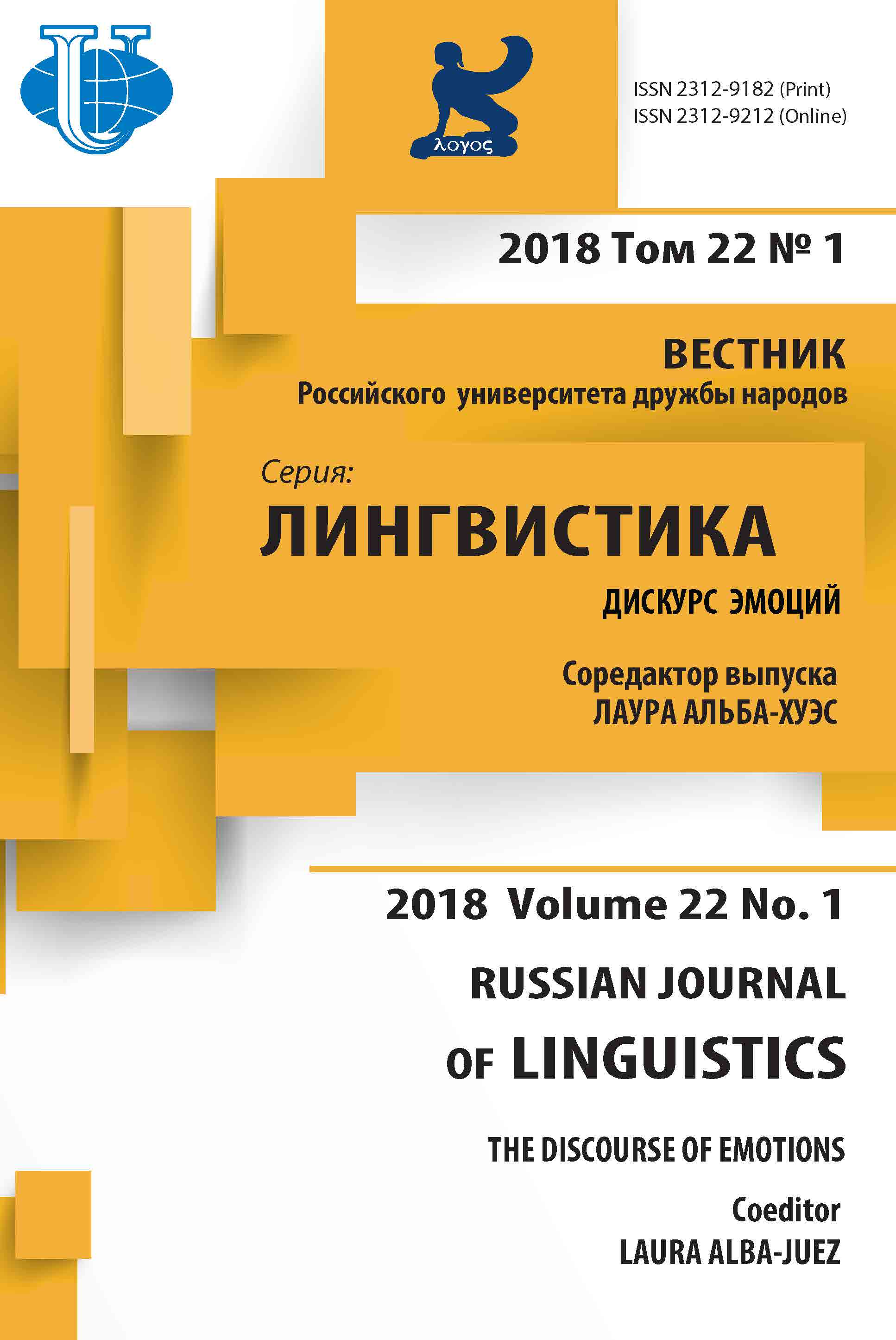EMOTIONS OF JESUS
- Authors: Wierzbicka A.1
-
Affiliations:
- Australian National University
- Issue: Vol 22, No 1 (2018): The discourse of emotions
- Pages: 38-53
- Section: Articles
- URL: https://journals.rudn.ru/linguistics/article/view/17846
- DOI: https://doi.org/10.22363/2312-9182-2018-22-1-38-53
Cite item
Full Text
Abstract
In a book entitled The Sermon on the Mount: The modern Quest for its meaning, theologian Clarence Bauman (1985) discusses, inter alia, Jesus’ teaching on “anger”. The book opens with a chapter on Tolstoy: “Leo Tolstoy: The moral challenges of literal interpretation”: “Christ’s first commandment is “Do not be angry” (Matthew 5: 22-25). Tolstoy noted that the text had been tampered with by redactors. By the fifth century the word εικη, meaning “needlessly” or “without cause,” had been inserted into the initial uncondi-tional statement: “Whosoever is angry with his brother without a cause...”. But what did Jesus really teach about “anger”? The term used in Matthew’s Gospel (5:22) is of course not the English word anger but the Greek word orgizomai - and the two don’t mean the same. The term used by Tolstoy - the Russian word gnevat’sja - is different in meaning from both anger and orgizomai. But the word used by Jesus was neither English, nor Greek, nor Russian, but Aramaic. So what did that Aramaic word mean - and what did Jesus intend to say with it? Tolstoy’s impulse to look for the “literal interpretation” is understandable, but as this chapter shows, the idea that we can pinpoint what Jesus meant with one word, from a particular lan-guage (be it Russian, English, Greek or Aramaic) is simplistic. The paper argues that in order to fully under-stand Jesus’ teaching about “anger” in a precise and unbiased way, we need to go beyond single words of this or that language, and to try to articulate it through simple sentences couched in universal (i.e. universally-contestable) words. Furthermore, the paper shows that what applies to Jesus’ teaching about emotions applies also to Jesus’ “emotional practice”. What did he feel when he saw someone doing some-thing very bad, or someone to whom something very bad was happening? As the paper demonstrates, the “Natural Semantic Metalanguage” (NSM) developed by the author and colleagues allows us to replace crude formulations such as “Did Jesus feel angry?” or “What did Jesus teach about anger?” with questions which are far more fine-grained, and which enable us to reach far more fine-grained, and more meaningful answers.
About the authors
Anna Wierzbicka
Australian National University
Email: anna.wierzbicka@anu.edu.au
ANNA WIERZBICKA is a Professor in the Linguistics Program, School of Languages, Literature and Linguistics, Australian National University. Her work spans a number of disciplines, including anthropology, psychology, cognitive science, philosophy and religious studies as well as linguistics, and has been published in many journals across all these disciplines. She has published over twenty books and edited or co-edited several others. Canberra, 0200, Australia
References
- Averintsev, Sergej (2007). Sobranie sočinenij [Collected works]. Kiev: Dux i Litera.
- Butwin, Frances (1958). Translator’s introduction to Sholom Aleichem [Rabinowitz], The Old Country. London: Andre Deutsch.
- Chesterton, G.K. (1908). The Everlasting Man. Radford, VA: Wilder Publications.
- Crenshaw, James L. (1993). Murder. In Bruce M. Metzger and Michael D. Coogan, The Oxford Companion to the Bible (532-533). New York; Oxford: Oxford University Press.
- Durst, Uwe. 2001. Why Germans don’t feel “anger”. In Jean Harkins and Anna Wierzbicka (eds.), Emotions in Cross-linguistic Perspective, 115-148. Berlin: Mouton de Gruyter.
- Elliott, Bianca (2006). The Emotions of Jesus. Martinsville, IN: Airleaf.
- Goddard, Cliff (1991). Anger in the Western Desert: A case study in the cross-cultural semantics of emotion. Man 26 (2): 265-279.
- Goddard, Cliff (2014). Interjections and emotions (with special reference to “surprise” and “disgust”). Emotion Review 6 (1): 53-63.
- Goddard, Cliff and Anna Wierzbicka (2014). Words and Meanings: Lexical Semantics Across Domains, Languages, and Cultures. Oxford: Oxford University Press.
- Goddard, Cliff and Anna Wierzbicka (Eds.) (1994). Semantic and lexical universals: Theory and empirical findings. Amsterdam: John Benjamins.
- Goddard, Cliff and Anna Wierzbicka (Eds.) (2002). Meaning and universal grammar: Theory and empirical findings (Vols. 1-2). Amsterdam: John Benjamins.
- Goddard, Cliff and Zhengdao Ye (Eds.) (2016). “Happiness” and “Pain” across Languages and Cultures. Amsterdam: John Benjamins.
- Goddard, Cliff (Ed.) (2017). Minimal English for a Global World: Improved Communication in Fewer Words. Palgrave.
- Greek-English Dictionary of the New Testament (1971). London: United Bible Societies.
- Law, Robert (1915). The Emotions of Jesus. Edinburgh: T & T Clark.
- Matisoff, James (2000). Blessings, Curses, Hopes and Fears: Psychoostensive expressions in Yiddish. Stanford, CA: Stanford University Press.
- Rosten, Leo (1968). The Joys of Yiddish. New York. McGraw-Hill.
- Voorwinde, Stephen (2011). Jesus’ Emotions in the Gospels. London: T&T Clark.
- Wierzbicka, Anna (1992). Semantics, Culture and Cognition: Universal human concepts in culturespecific configurations. New York: Oxford University Press.
- Wierzbicka, Anna (1999). Emotions Across Languages and Cultures: Diversity and Universals. Cambridge: Cambridge University Press.
- Wierzbicka, Anna (2004). Jewish cultural scripts and the interpretation of the Bible. Journal of Pragmatics. 36(3), 575-599.
- Wierzbicka, Anna (2009). Language and metalanguage: Key issues in emotion research. Emotion Review. 1 (1) 3-14.
- Wierzbicka, Anna (2014). Imprisoned in English: The hazards of English as a default language. New York: Oxford University Press.
- Wierzbicka, Anna (2017). W co wierzą chrześcijanie? Opowieść o Bogu i o ludziach [What Christians Believe: The Story of God and People]. Cracow: Znak.
- Wierzbicka, Anna (Forthcoming). What Christians Believe: The Story of God and People. New York: Oxford University Press.
- Ye, Zhengdao (2001). An inquiry into sadness in Chinese. In Jean Harkins and Anna Wierzbicka (eds.), Emotions in Cross-linguistic Perspective, 359-404. Berlin: Mouton de Gruyter.

















